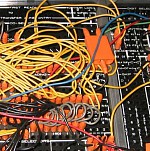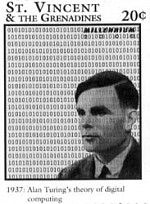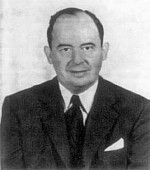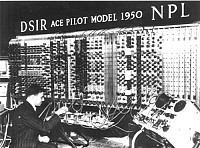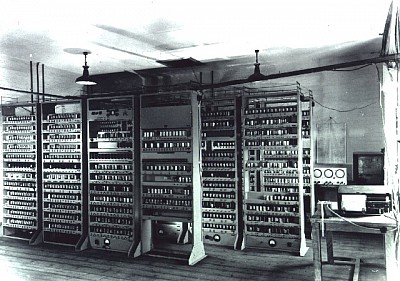Computer Science
Computing History Displays: Computer History Time Line - Steps towards the first stored-program computers
Here we cover the period, centered on the late 1940s, before the first modern computers were constructed. Interestingly, what computers could do and how they could be designed, were well understood before the machines themselves appeared.
Electronic calculation was much faster than mechanical. However, electronic calculators were being held to a fraction of their potential because of the way they were controlled by either wiring of plugboards or obeying programs read mechanically from a sequence of instructions on cards - plugboards were too inflexible and card readers too slow. It became clear that that the computer could be "unleashed" only if the program steps were themselves stored within the machine's memory and made available at near-electronic speeds.
In 1936, Alan Turing, a brilliant Cambridge university mathematician, proposes an abstract model of what a computer would be and defines precisely what work it might do. His abstract machine - the Universal Turing Machine - becomes the basis for the theory of computation. The UTM mixes instructions and data in the same memory. Turing goes on to work on cryptanalysis during World War 2 at Bletchly Park. He designs practical decoding machines including the "bombe" used on the Enigma codes. Further Images.
3.1.2 Design standard
John von Neumann, a Hungarian-born mathematician at Princeton University, worked with the ENIAC designers on the design of a stored-program successor, the EDVAC. His later computer built at the Institute for Advanced Studies at Princeton University, described in detail in the paper "Preliminary discussion of the logical design of a computing instrument", has great influence throughout the world. "Johnniac" machines will become the standard concept for what a computer is, and their style of design will be known as the von Neumann Architecture. Further Images.
3.1.3 ACE trumped
Meanwhile, Turing himself starts designing a real - rather than theoretical - computer, the ACE and writes a report at the UK National Physical Laboratory in 1945 describing his proposed machine and what it could be used for. His approach is quite different from von Neumann's. He wants a fast machine that is easy to build. The first version, the Pilot ACE, is the fastest of the early British computers, but it is not the first computer constructed, being delayed until 1950. Further Images.
Turing also makes contributions to the application of computers in Numerical Analysis and Artificial Intelligence. His 1945 report is brilliant in the breadth of its coverage, from the details of the technology, through the design, to possible applications including playing chess. Crucially, he understood the importance of programming ("constructing instruction tables") to the use of computers, before they were invented, when he wrote:
This process of constructing instruction tables should be very fascinating. There need be no real danger of it ever becoming a drudge, for any processes that are quite mechanical may be turned over to the machine itself.
The post-war years see many projects to build working, usable computers on the von Neumann model. A "baby" computer with 128 bytes of memory is operating at the University of Manchester in 1948 and there is a definitely usable EDSAC computer at Cambridge University in 1949. The main technology problem of the first computers is illustrated by these two British machines. The Manchester computers use memories that store data on the surface of cathode ray tubes - these are fast, but unreliable. The Cambridge computer uses a recirculating memory. These memories are cheaper and reliable but serial (accessing one bit at a time) and slow. Recirculating memories, which use sound traveling in tanks of mercury (as in EDSAC) or along wires, or data stored on magnetic drums, are common in the work-horse computers of the 1950s. Computing as we understand it awaits the invention of better systems of memory. Further Images.
Here is the EDSAC:

